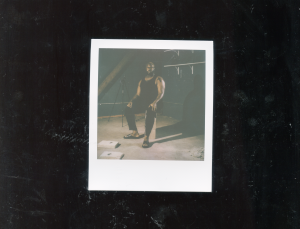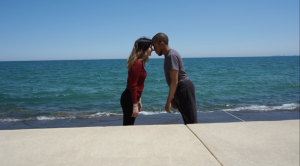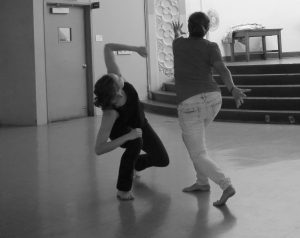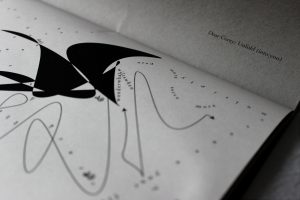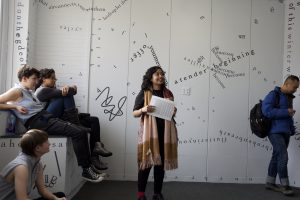
- To Art + Profit Logo, 2011. (Image courtesy of Meida McNeal.)
The question of financial value when discussing art has always proven to be a difficult one. How do you place a dollar sign on the work and services of artists? The process for assigning value, it would seem, is as mysterious as the process used to build the Pyramids of Giza or to haul those massive lintels onto the posts of Stonehenge. The process is just as mysterious, if not more.
All joking aside, the term ‘starving artist’ makes most of us in the creative field cringe–and with good reason. Why should the shapers of our culture starve when they are the ones creating our legacy? When the topic of money comes up, why should it be an uncomfortable one? And, finally, why do we have the tendency to undervalue ourselves as artists, art scholars and art administrators, etc.–or allow others to?
These are some of the questions that the programming around the spring performance festival To Art + Profit: Creative Labor, Collective Action and Conscientious Capitalism at Links Hall will address. The brainchild of artists Meida McNeal and Abra Johnson, To Art + Profit invites the public to voice their thoughts and answers to these questions through conversation with people in our city who may have some insights to our money issues.
To find out more about the event and its creators, I asked Meida McNeal a few questions about her work as an artist and dug a little deeper into the questions and concepts surrounding To Art + Profit.

Tempestt Hazel: How long have the two of you been working together?
Meida McNeal: We have been working together as creative associates for over a decade now. We started out as co-founders of ThickRoutes Performance Collage along with Felicia Holman, Aisha Jean-Baptiste and Michelle Mashon. More recently, several of us have reconfigured as The Ladies Ring Shout. We are also now developing work on Chicago house music and dance as a lifestyle and consciousness in addition to co-curating the To Art & Profit festival which considers the value of creativity and creative labor in our moment.
Our creative approach has always been interdisciplinary at the intersection of art, scholarship and advocacy. Cultural studies, ethnography and sociology are key methods of inquiry we use to ask questions about society and to interrogate established scripts of race, class, gender, sexuality and discourses of belonging. We are interested in disrupting our everyday perceptions, telling hidden stories and building community through our art works.
TH: What led to the development of To Art + Profit?
MM: For years we have been having an ongoing conversation about the value of creative labor in our own artistic circle. We’ve had many discussions about how the arts help us to communicate and come to new understandings about ourselves and each other. We’ve also discussed how creativity informs so much of the world around us yet creativity is yet to be valued for its true worth. We realized that variations of this conversation are being had by artists everywhere. We all want better strategies for making a sustained living from our creative work. We all want the public to realize how much goes into the practice of art-making, from being a one-person creative and administrative machine to understanding the ways artists have to balance art-making with their personal lives, often searching for other revenue streams to keep their creative practices afloat.
We thought it would be an amazing artistic experiment to bring together artists in a variety of disciplines to discuss, debate and create together on this question of the value of creativity and creative labor. What new strategies and approaches might artists come away with? Could this lead to a new support system for local artists talking about their relevant issues, sharing resources and perhaps taking some sort of collective action to recognize the impact of creativity on all of us as humans?

TH: How did you select the artists that are involved? How is Links Hall affiliated?
MM: We are both interested in cultural programming and how we can use performance to incite dialogue with community. The Artistic Associates Program, a curatorial mentorship program offered by Links Hall, allowed us an incredible opportunity to try our hand at programming out under the guidance of Roell Schmidt, the Director, and with incredible support from Marie Casimir, who handles Communications & Marketing.
As native Chicagoans, we both love this city with a passion. Yet we are often disappointed with the narrowness that can shape Chicago’s creative sector. Even though we know lots of diverse artists doing great things, we aren’t hearing those voices with the volume and intensity we think we should. So we wanted to recognize these local artists, bring their voices to the fore and to give them a platform – through the festival – to offer up their perspectives on the state of the arts in our city. We selected an interdisciplinary hodge-podge of twenty-five artists including writers, dancers and musicians because we wanted to see how these different mediums speak to each other. What would these creative folks have to say to each other? What kinds of creative statements might they make together? And how might they challenge each other?
TH: You chose to have each part of the three-part festival in different neighborhoods around the city. How were the neighborhoods chosen? Why is it important to move this around Chicago?
MM: The neighborhood component is a vital aspect of the festival’s objectives – to reach and engage Chicago’s communities in a discussion about the labor and purpose of creativity.
We want to drive home the idea that much of Chicago’s incredible art scene is happening in its neighborhoods, not just in the city’s established theaters and downtown performing centers. At the same time we also wanted to bring attention to the reality of Chicago’s artistic deserts. How can we advocate for more decentralized cultural production in our city? Can we imagine storefronts or cultural community centers in our city’s South and West sides, areas often neglected in terms of cultural infrastructure (though not lacking in terms of creative potential, including creative people)? To Art & Profit emphasizes both performance and community dialogue as ways to think through possible scenarios of collective action. These small steps can potentially bring us closer together to think through functional solutions to the issues that affect us all around the impact of the arts and creative labor.
We wanted to connect artists to communities they might not typically be part of. We acknowledge that there is a lot of creative segregation in Chicago and that this division mirrors Chicago’s long history of racial/class segregation. In some small way, we want to confront that division by bringing artists to talk through and create around these issues directly in neighborhoods they don’t usually encounter with their art.

We also built the festival with the idea that it would offer many ways to enter the conversation. In addition to the performances at Links Hall Friday and Saturday nights, there is a Sunday spectacle in different Chicago neighborhoods – Logan Square, Pilsen and Bronzeville. We have asked artists to collectively work together to create some kind of performed experiment that engages the community with some of these issues surrounding art and value. So, for instance, the March artists decided to do mini-workshops in which they take community participants through some of the strategies they use in their own art-making processes. We are also hosting a series of panels in each neighborhood that widen the discussion to include arts advocates and educators in addition to the artists themselves.
TH: As far as the main questions that you are asking the participating artists to address are concerned, what experiences have you had in your own careers that have served as a testament to the necessity of this dialogue? (What is the value of creative labor? How can we practice a more conscientious capitalism, one that allows art makers to make a living while still nourishing the human spirit? How can we democratize art production, widening the scope of creative voices and expressions brought to public spaces and stages?)
This festival aims to bring to light all the creative labor that is so often hidden: rehearsals, scheduling, sourcing gigs, marketing, promotion, generating creative material, managing childcare or family obligations around creative work. How can we talk about all that goes into the art-making process? We want to generate a conversation that acknowledges this multilayered work. How can we be open about what we risk to make the art we love? Can I make a living teaching art? Will I be able to pay my bills? Is this the best use of my skills in the society that we live in? We ask the artists to be vulnerable, to speak the truths of their circumstances as practicing cultural workers. And we ask everyone to imagine what the world would be like if we could shift perceptions to value creativity in the way we value other services, professions and skills – and the way we as artists value creativity ourselves. What would it be like if we could truly say the world valued its artists, not as geniuses or exceptions, but as part of a sustained labor force that contributes to society by helping others to express themselves or by illuminating aspects about our lived world that make us reflect?

TH: Why, in your opinion, is placing value and worth to creative products and services such a difficult conversation to have and such a complicated or mysterious process?
MM: Part of it comes from the very arbitrary nature of how we assign value. Why is A worth more than B? Why do certain forms of work that require similar levels of education or similar skill sets differ so wildly in amount of pay? Is it really based on anything solid? We are taught to assign monetary value to products and material things. It is much more difficult to conceive that artistic work has a dollar value because it doesn’t fit the formula of exchanging money for a product that is considered functional or essential to daily life. But when you really think about it, the arts are essential. They help us process and understand the world. They help us engage in positive social interaction.
It would be brilliant if we could come away from this festival with some ideas about how to make art’s value more tangible. Maybe it’s an assessment of teaching artists labor – what should be the going rate for teaching, curriculum development, course prep, overtime? Or it doesn’t have to be dependent on our current monetary system. Maybe barter and trade, maybe we find some way to operate as a collective. Maybe it’s a community system where local artists of all different mediums can go to exchange services to support the creation of new work. Maybe it’s the creation of a collective live artists fund to make a mobile production kit – marley floor, some lights, an audio system, etc. – that artists can rent for a small fee to put up their work.
TH: I recently had a discussion with a friend who said that conversations about pricing and value are not conversations that should be had in institutions because it takes the focus away from artistic development. What are your thoughts on that?
MM: We’re only hurting ourselves further if we don’t bring this conversation to the classroom and other institutions where the arts live. Students investing in creative disciplines need to have an honest idea of what they will meet outside the spaces of their institutional homes. Transparency about what it takes to find ways to support one’s creative work gives young artists an opportunity to learn the ropes of networking, marketing, grant sourcing and the like. And having serious discussions about pricing/value gives one an honest idea of what s/he should charge for an “artist’s fee” when crafting a budget or thinking about how s/he should be compensated for the hours spent making new work.
TH: The festival also seeks to explore ways in which art can be profitable, accountable and accessible. I understand the profitable and accessible (by moving it throughout the city), but what do you mean by accountable?
MM: By accountable, I think we are addressing a need to make more space for creative work that is focused on social justice, focused on spirituality and faith and focused on living good with one’s neighbors or in one’s community. This kind of work is valuable. It edifies people’s hearts and spirits. It affirms life. Independent community-focused creative work can share space with more commercial mass-produced creative work. Why are we so obsessed with ballet or Broadway or the symphony as these elite “cultured” spaces yet we refuse to acknowledge the power of a drumming circle, of folk dance, of spoken word or improvisation that may not be suited for huge theaters, that may be built for mid-size or more intimate spaces? Just because these forms of cultural production are smaller in volume, does that make them less important, less cultured? No, it doesn’t – or it shouldn’t.
TH: Are there specific aspects of artistic practice and profit that are particular to Chicago’s creative community, or do you feel that this is a conversation that could take place in other parts of the country and globe?
This is a conversation that should be, can be, and is happening everywhere. I have been doing cultural research in Trinidad on the cultural production system there for over a decade and I continue to be amazed at how struggles are often similar for artists in both locations. Artists are shouting to be acknowledged for their labor, for their cultural contributions and impact on communities.
TH: What can people expect at the fundraiser?
MM: A good-ass party! We’ve got two great Chicago house DJs – Jo De Presser and Jason J Grilla Green. There will be drinks and finger foods, short performances from artists and a raffle. Come through. Let it be your opening to Spring revelry! And you can support your local creative economy at the same time!
—
To Art + Profit will be holding events and programming on the following dates:
March 18-20: What Is It Good For? Defining Art’s Purpose Now
March 25, 2011: To Art + Profit Fundraiser at Joseph Raven’s Defibrillator: A new performance gallery in Wicker Park
April 15-17: Quit Bullshittin’: Recognizing Division and Building Solidarity
in the Arts
May 20-22: Come As You Are: Re-Imagining Art with a Conscience
Join the conversation by visiting their website: www.toartandprofit.wordpress.com. Watch the trailer for the festival by SubVerse Studios HERE.
“The goal is for each of you to share your stories about the value of creativity and creative labor. If art has affected your life or if art-making is an integral part of your lived experience, then we want to hear what you have to say.” — Meida McNeal
